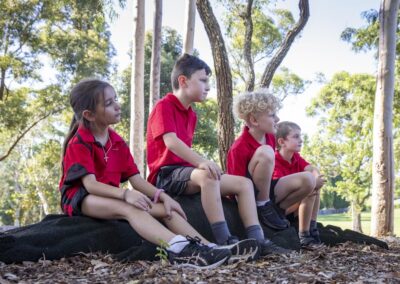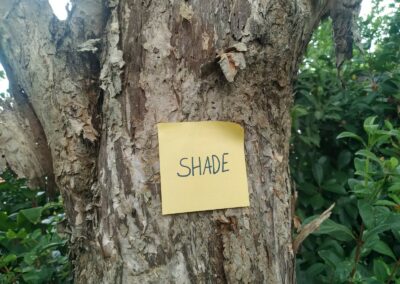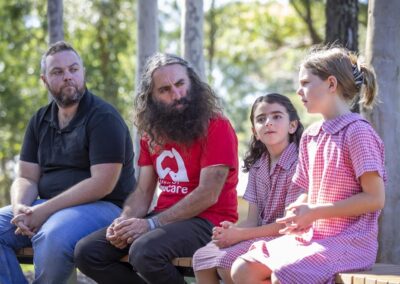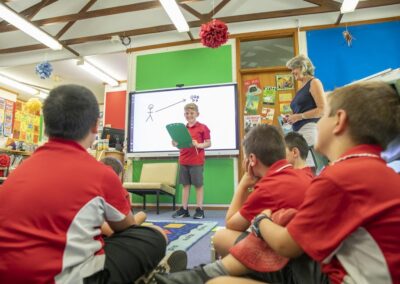LEARNING ACTIVITY
STORY
Mrs Smith was just about to head off to class when the Principal, Mrs Collins, popped her head into the staffroom: “Good news!” exclaimed Mrs Collins. “We got that grant for the yarning circle… Now to decide where to put it?”
“How about I check with Jarrah and his friends?” suggested Mrs Smith. “They might have some ideas and they could get some feedback from our First Nations community members, too.”
“Oh yes, good idea!” said Mrs Collins. “I was thinking that area next to the basketball court – there’s a bit of a space there.”
“I’m not sure,” replied Mrs Smith. “That space is often busy during PE, recess and lunch.”
“You’re right,” said Mrs Collins. “Perhaps that’s not the best place for sharing ideas and contemplation. Oh well, have a chat with them and let me know. We have a School Council meeting next week so it would be great to get it on the agenda ASAP.”
“OK, I’ll speak with everyone and we can see if the students can come up with some ideas for spaces they think could work.”

This activity is the second activity in an 8-part activity sequence that has been developed to help you design, build and use a yarning circle at your school or community space.
This activity expands on the concept of a yarning circle and its importance in First Nations Culture, and will help guide you in finding a suitable site to situate your yarning circle.
The order of these learning activities are: background, site selection, involving First Nations people, building the yarning circle, connecting to Landcare, using the yarning circle, yarning circle activities and yarning and wellbeing.
For children to:
- understand the spatial requirements for a yarning circle
- consider how the location of a yarning circle can enhance its use
- assess different spaces and appreciate how some spaces could be more suitable than others for a yarning circle
- produce a persuasive argument as to why their preferred space should be chosen.
This activity can be undertaken at any time of the year.
Introduction
Now that you’ve decided you would like to set up a yarning circle in your school or community, it is important to figure out where to place your seating area. Important things to consider include:
The physical area or location:
Seating:
Visibility and accessibility:
Once you have gone through the important considerations above, you can start thinking about how to design your yarning circle space to bring it to life.
The next learning activity ‘Creating a yarning circle: involving First Nations people’ will provide tips on how to get the local Aboriginal and Torres Strait Islander community as well as the broader school community involved.
Checklist
Instructions

STEP 1
Introduction:
Begin this activity with an Acknowledgement of Country. By acknowledging the Land, you are also making a promise that you will recognise the Cultural practices of First Nations people.
Before you head outside, explain that today you will be comparing different sites to decide where to set up a yarning circle and to produce a persuasive argument about the preferred site.

STEP 2
Site evaluations:
If you are able to work with a local Elder or First Nations group, getting their feedback about the pros and cons of a particular site can be valuable in helping to select the right location.
Begin by going to a location that you think would NOT be a suitable site for a yarning circle. Explain that you think this probably wouldn’t be a good site.
Hand out post-it notes and pencils.
Sit in a circle and ask the students to evaluate the site and explain whether there are positive or negative aspects to the location. Ask the students to record these ideas on a post-it note.
Repeat the process with the site(s) that could be better.

STEP 3
Discussion and elaboration:
As a group, share your observations and the data collected on the post-it notes. If possible, it is a good idea to do this whilst sitting in the preferred space for your yarning circle. Some guiding questions include:
- How well do we all fit in this space?
- How do we feel when we’re in the area?
- How well can we see and hear one another? How well can we be heard?
- What access requirements might we need to consider in this space?
Consider the positive and negative aspects of the different locations.

STEP 4
Persuasive writing:
Distribute the Writing Frame Activity Sheet.
Ask students to use the Writing Frame as a template to produce a persuasive argument. Their persuasive argument should be why the site chosen would be the best location to situate the yarning circle.
Present the arguments to School Leadership/Council and seek their feedback about the site you have selected.
Extension Activity
Either formally (with a sound meter) or informally, measure the volume of background noise at various parts of the school.
Using a map of the school, review the location of the admin office, classrooms and amenities, like bathrooms. Theorise as to why they have been located there.
Curriculum and Framework Links
SCIENCE
Year 5: ACSHE083
Year 7: ACSHE120
Year 8: ACSHE135
HUMANITIES AND SOCIAL SCIENCES
Year 2: ACHASSI042
Year 3: ACHASSI052, ACHASSI059, ACHASSI060
Year 4: ACHASSI080, ACHASSK088, ACHASSK090
Year 5: ACHASSI102, ACHASSK120
Year 6: ACHASSI122, ACHASSI130
DESIGN AND TECHNOLOGIES
Year 2: ACTDEK003
Year 3 & 4: ACTDEP017
Year 5 & 6: ACTDEP019
Year 7 & 8: ACTDEK032
HEALTH AND PHYSICAL EDUCATION
Year 2: ACPPS018, ACPPS022, ACPPS023
Year 3 & 4: ACPPS036, ACPPS040, ACPPS041
Year 5 & 6: ACPPS054, ACPPS059
Year 7 & 8: ACPPS073, ACPPS078
ABORIGINAL AND TORRES STRAIT ISLANDER HISTORIES AND CULTURES
ETHICAL UNDERSTANDING
Exploring values, rights and responsibilities.
PERSONAL AND SOCIAL CAPABILITY
CURRICULUM CONNECTIONS
CROSS CURRICULUM PRIORITY
MY TIME, OUR PLACE: FRAMEWORK FOR SCHOOL AGE CARE
Reference List
ONLINE RESOURCES
Caring for Country (Primary) resource from Narragunnawali provides resource material for all students to build a personal sense of responsibility for respecting and caring for the Country/place around them, all the while building an awareness and appreciation of Aboriginal and Torres Strait Islander contributions to sustainable Land management.
PRINTABLE RESOURCES
Queensland Family and Child Commission: Printable Yarn Up Cards
WATCH
Principal Mills in conversation with Junior Landcare ambassador Costa about how her school went about selecting the best site to locate their yarning circle.
READ
The SBS NAIDOC Week teacher resource provides a background on the importance of teaching and celebrating First Nations perspectives.
NETWORK
We recommend reaching out to the Local Traditional owners and First Nations peoples community groups who can assist in knowledge sharing and understanding local land, language, stories and culture.
To reach out or find contacts in your local First Nations community you could speak to parents of First Nations students, to an Indigenous Learning Officer (ILO) at your school or to a local Land council.
We have some suggested organisations to approach listed on our Junior Landcare Community page.
We value your feedback
When you have finished this learning activity, please tell us what you think with our survey.
Your feedback will help Landcare Australia improve the activities in the Junior Landcare Learning Centre.
Why not try one of our other Junior Landcare learning activities?
Creating an Indigenous plant-use garden: plant list
First Nations Perspectives
Creating an Indigenous plant-use garden: resources from the bush
First Nations Perspectives
Love Letters to the Land
Biodiversity|First Nations Perspectives|Food Production|Waste Management
Creating a yarning circle: involving First Nations people
First Nations Perspectives